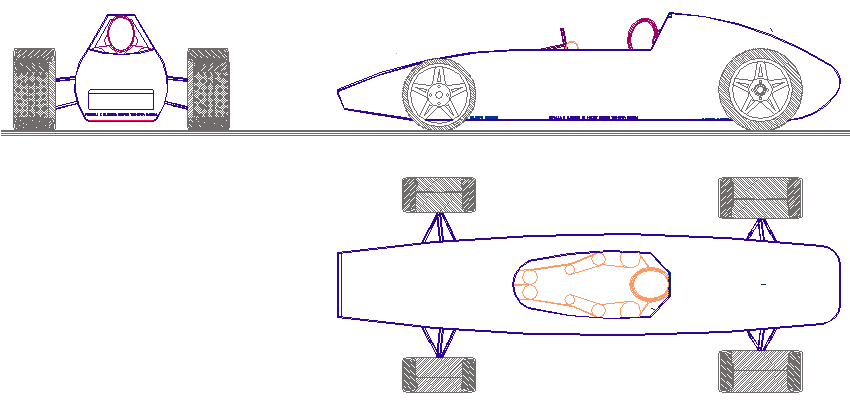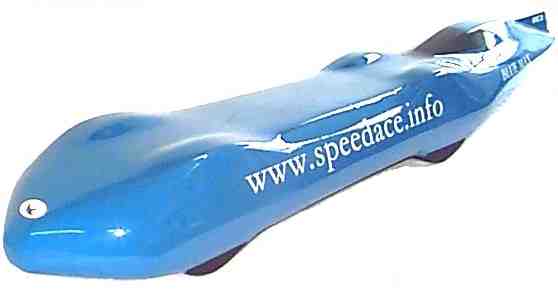|

The
above Formula E design has built in high-speed power loading for its battery
cartridges, allowing pits tops in around 10-15 seconds. At the moment, Formula E
racers have to swap cars. They need two cars to race with the fast charge system
advocated by Lord Drayson and his very fast
Mclaren conversion. The system is a
high-speed development on that used in the Blueplanet Ecostar, for which an
improvement patent in being
prepared, hence we cannot reveal how it works. Free licenses are available for
developers.
-
Number:
29/G/ENT/CIP/12/C/N05S00 - Promotion of electric vehicle
technologies
GRANT
PROGRAMME 2012
LOT
1: Construction from scratch of an electric car designed for competition.
THE
PROPOSAL: ‘BLUEPLANET ECOSTAR’
-
To
design and build from a clean sheet of paper, a high-performance electric
vehicle designed to attempt to set a new European electric land speed record
(LSR).
-
The
vehicle is to be known henceforth as the ‘Blueplanet Ecostar’, is to
incorporate what is probably the ultimate range extender, being the ability
to refuel itself by way of a battery cartridge exchange, within minutes.
-
The
challenge is to incorporate a battery cartridge, which will provide a useful
range for a road going electric vehicle, and not only exchange a cartridge
after a high-speed run, but that the vehicle may do this by means of built
in apparatus.
-
At
present the Federation Internationale de la Automobile (FIA) LSR rules allow
the best of 3 runs in opposite directions across a measured mile, within 1
hour. The two best runs in opposite directions are then added together and
divided by 2 to give your average flying mile speed.
-
The
3 run rule is not practical for EV’s without cartridge exchange, because
their first and second run payloads would seriously hamper performance,
where the vehicle mass would be significantly more. Put simply the vehicle
would be 2-3 times heavier than a vehicle that can refuel instantly. Thus,
to now, electric LSR vehicles have attempted two runs out of three, with
fast charging in between, replenishing around 30% of the available battery
capacity for the second run, and so on.
-
‘Blueplanet
Ecostar’ may complete three runs with a fresh cartridge for each of the
three attempts.
-
The
battery cartridge exchange system (BCES) to be incorporated in ‘Blueplanet
Ecostar’ has been verified officially by the governing body of motor
sport, the FIA, as a means of refuelling.
-
The
battery cartridges will be charged by way of portable solar arrays, to make
the vehicle and any demonstration of the vehicle, entirely powered by energy
from nature. (IEC 61000)
-
The
battery cartridges will use the latest Lithium Polymer cells commensurate
with budgetary constraints, the charge rate electronically regulated.
-
The
‘Blueplanet Ecostar’ will also carry onboard photovoltaic (solar) cells,
that the sun may provide a percentage of electricity directly, calculated to
enhance the performance of the vehicle.
-
The
reason for using solar arrays to charge battery cartridges is to demonstrate
that with the necessary investment and incentives, that power for
transportation may come from renewable energy from nature. (See the Utopia
Tristar proposals for housing with community charging of battery
cartridges).
-
‘Blueplanet
Ecostar’ will incorporate a constantly variable transmission (CVT), which
has the benefits of faster acceleration for sports vehicles or greater range
for road vehicles.
-
‘Blueplanet
Ecostar’ will use lightweight DC motors that provide operating
efficiencies in the 80-90% range, when coupled to the CVT transmission. The
simplicity of this design obviates the need for heavy and expensive wave
generators. Soft start is provided for the initial acceleration phase to 50
mph, after which the traction motors may be direct coupled to the traction
batteries without wheel-spin.
-
The
designer of the system was granted a UK patent in respect of such battery
exchange technology in 1995. The system has not been developed past 2000 and
the patent lapsed, for lack of commercial interest and/or support for
battery vehicles.
-
The
car’s output will be 400Kw for a flying mile speed of 350mph. This level
of performance being close to the performance of many world record petrol
LSR vehicles and far in excess of most circuit racing petrol vehicles.
-
It
is hoped that motor vehicle manufacturers (MVMs) will be sufficiently
persuaded by the battery exchange system, to want to take the innovation to
the next stage – which is to agree a format that all MVMs can cooperate on
for the next stage in EV evolution: no range restrictions.
-
In
1995 the designer constructed from scratch a racing vehicle, incorporating
an inbuilt battery cartridge exchange mechanism powered by pneumatic servos.
This allowed refuelling in about 2 minutes and attracted coverage from the
Mail, Telegraph, Sunday Times, Autocar, and Big Breakfast.
-
In
1999 the designer converted a Rover Metro to electric drive, incorporating
flat electro-mechanical servos for battery cartridge exchange. This was to
demonstrate that the racing car system was suitable for road cars.
Alterations to the floor-pan central tunnel and rear cargo floor-space were
minimal. This car was never put on display for lack of funds.
-
It
is hoped that by drawing attention to the battery cartridge exchange method
of range extension for EV’s that motor manufacturers may become interested
in developing the technology commercially.
-
Regardless
of the potential for development for future production vehicles, this/these
present proposal(s) is/are not a commercially viable enterprise, nor are the
immediate objectives commercially driven or for profit.
-
Other
transitional hybrid arrangements are described in the designer’s patent GB
225337. If motor manufacturers might be persuaded to explore the commercial
applications of a unified (universally accepted) battery cartridge for their
exchange systems.
-
Hybrid
vehicles may offer the technology-gap transition from petrol, to hybrid, to
pure battery exchange vehicle.
-
The
logical future development of the BCES as incorporated in ‘Blueplanet
Ecostar’, is to pilot test automatic battery cartridge dispensing
equipment, or service stations.
-
The
BCES in any of the formats used previously, or to be used in the
‘Blueplanet Ecostar’ is suitable for incorporation in electrically
powered circuit racing cars, where the need for extremely fast refuelling
during pit stops, will accelerate the development of forecourt service
stations for EVs.
RANGE
ANXIETY - The blend of technology to be incorporated in the ‘Blueplanet
Ecostar’ promises an innovative energy efficient vehicle, devoid of range
restrictions, provided that the infrastructure is also developed and given the
support necessary by the member states of the European Union.
CLEAN
MOTORING - Electric vehicles incorporating a means of instant refuelling could
make road transport clean and practical by eliminating the limited ranges of
fixed battery EVs, which are perceived as less practical by the at present long
parked-up recharge times.
The
cartridge exchange technology incorporated in ‘Blueplanet Ecostar’ may
contribute to the spread of innovative battery solutions for EVs and raise
social awareness of this developing technology, thus meeting the objectives of
this call.
Motoring
enthusiasts will enjoy the spectacle of a sleek racing car at shows and other
events. As the media pick up the story, the general public should warm to the
news of instant refuelling as may benefit carbon reduction targets, but it is
hoped that MVMs, energy suppliers, NGO’s and governments will recognise the
potential. In 1995 a well known energy supplier in the UK entered into
negotiations with the designer, which faltered as the Dti revealed its
preference for fuel cell technology, now discarded.
POWERTRAIN
- The ‘Blueplanet Ecostar’ uses a pure battery-electric power-train to be
complemented by the addition of onboard PV cells.
VEHICLE
SAFETY - The driver is protected by
a safety cage and CTA compliant rollover bar. Goodyear high-speed LSR tires are
rated higher than the expected operational speeds. A parachute and safety
reserve chute supplements conventional disc braking. The battery cartridge
casing provides extra mechanical and fire protection to the Lithium Polymer
cells in the event of a crash. The loading and cradling design helps the cells
to resist vibration. Short circuit, over an under charge protection is
incorporated. Specifically, the system complies with the requirements of UNECE
Regulation No 100 (electric safety). The
system will be tested statically and in rolling situations.
ENVIRONMENTAL
CONSIDERATIONS
-
The
frame of the vehicle will be constructed of corrosion resistant metal.
-
The
bodywork of the vehicle is to be constructed of durable aluminium alloy and
composites.
-
Paints
will be water based.
-
As
a showpiece the Blueplanet Ecostar will not be recycled, save for the
Lithium batteries and will be displayed at local and science museums across
Europe.
-
The
solar charging arrays will be re-deployed for electricity production for
such displays.
BATTERY
CARTRIDGE CHARGING - The battery cartridge solar charging system shall comply
with the EU legislation and international standards, such as IEC 61000.
Alternatively, battery cartridges may be recharged via a charger of the onboard
type in any country within the EU and US. For road cars, a smart-card Pay As You
Drive (PAYD) system may be developed for forecourt style commercial battery
cartridge exchanges.
ELECTROMAGNETIC
COMPATIBILITY (EMC) – The vehicle will be designed to meet with or exceed the
tolerable limits set for electromagnetic disturbances as defined in EU
legislation. and shall take into
account additional issues not covered totally or partially by the latter, such
as those related to connections to the power grid.
g)
Applicability to future society in terms of carbon reduction and the take of
EV’s generally, once range anxiety issues become resolved, measured by the
following indicators:
-
Number of unique visitors to the project websites.
-
Media coverage of the demonstration event (number of press articles).
-
Estimation of impact on carbon generate transport if taken up by manufacturers.
CONSTRUCTION
TIMETABLE
(1)
Scheduled start-up date for the action: 15th July 2012
(2)
The duration of the construction is 4 months.

Project:
Blueplanet Ecostar
An
electric land speed record car that refuels itself by changing battery packs
between each run - charged by solar power.
Email:
 or phone UK:
or phone UK:
+
44 (0) 1323 831727
+44
(0) 7842 607865
Intelligent
Battery Support System
European
Commission | Enterprise
and Industry

Site
map | About
this site | Legal
notice | Contact
| Search
|



